Ford’s Coyote V8 history dates back to the 1980s. Forty years is an eternity, but don’t mistake current engines for old technology as evolution makes it one of today’s benchmarks.

Henry Ford didn’t invent the automobile or the V8 engine. But through innovation and ingenuity, he made both available to average consumers. Now, over a century from the first Model T and 90 years since Ford’s first V8 production car, the latest Coyote V8 engine is still sold in hundreds of thousands of Mustangs and F-150s. And it has a backstory that is equally as impressive as its enduring reliability.
In the early 1980s, Ford experienced a renaissance; first in design and then technology. It began with forward-looking designs like the 1986 Taurus, which was shaped as much in the wind tunnel as the design studio. Ford’s Chief Executive Officer at the time, Donald Petersen, knew the move into the future had to be more than skin deep.
The engineering department was tasked with making engines that could not only advance with consumers’ performance expectations and federal emissions requirements, but stay within the company’s budget constraints.
In 1990, Ford debuted its new V8 modular engine in the Lincoln Town Car. The single overhead cam 4.6L V8 was more powerful, more efficient, and lighter than the small block 5.0L it replaced. Just as important, the Romeo and Windsor manufacturing facilities would produce multiple versions of the engine for different applications without major changes to the assembly line.
Versions of the modular engine can be found in everything from Town Cars and Crown Victorias to Mustangs and Thunderbirds, and even in Ford F-Series Trucks and E-Series Vans. The four-valve double overhead cam version was reworked and repurposed into exotics like the Panoz and Koenigsegg. The flexibility of the modular design even allowed Ford to add two cylinders to create the 6.8L V10 for use in large trucks.

Modular Engine Becomes the Coyote
Competition brings out the best in everyone, including car manufacturers. In 2010, Chevrolet revived the Camaro after an eight-year break in production. General Motors chose a 6.2L LS3 pushrod V8 for the most potent version of its pony car competitor. Ford responded with a larger and more high-tech version of the Modular Engine.
For the 2011 model year, the S197 generation Mustang GT wore a 5.0 badge, this time with an actual 5-liter V8 and not a 4.9L like earlier small block cars. It was significantly smaller than the competition from Chevrolet or Chrysler, but with multi-valve overhead camshaft heads, it would create comparable power.

First-generation Coyote Engine (2011-2014)
The 2010 Mustang received a mid-cycle refresh but retained the 4.6L Modular V8. It was a year later in 2011 when it received the first-generation 5.0L Coyote V8.
The Coyote represents a big step up in development from the 4.6L Modular Engine. The most important innovation is Ford’s Twin Independent Variable Cam Timing for the double overhead cam engine. Both the intake and exhaust cams can vary timing by fifty degrees independent of the other. Not only does this allow engineers to create more power, but it also allows for better fuel economy and fewer emissions over the entire RPM range.
The Coyote has roughly the same physical dimensions as the 4.6L V8 it replaced, which was judged to be a necessity in the design phase. The Coyote had to be able to fit in platforms that were designed the 4.6L.
The aluminum block uses pressed-in steel cylinder liners. Inside the aluminum heads, Ford used 37 mm intake valves and 31mm exhaust vales; two of each per cylinder. A composite intake manifold was used to reduce weight as well as reducing heat soak to keep the intake air as dense as possible.
The first generation of Coyote produced 420 hp at 6,500 rpm and 390 lb.-ft. of torque at 4,250 rpm. The Camaro’s numbers were 426 hp and 420 lb.-ft. of torque. The big Chevy still had more torque, but luckily the Mustang had a weight advantage.

Second-generation Coyote Engine (2015-2017)
The S550 Mustang saw many advancements, some of which enthusiasts considered long overdue. Under the back of the car, independent suspension replaced the live axle. But, under the hood, a revamped version of the Coyote kept the Mustang competitive in a straight line.
Again, Ford improved the breathing of the Coyote by reshaping the ports in the heads and increasing the size of the valves. Intake valves grew to 37.3mm while the exhaust diameter was increased to 31.8mm. Stiffening the valve springs stopped the valve float at high rpm to take advantage of the better breathing at the high-end.
In an effort to improve emissions, the TiVCT actuation was decreased from fifty degrees of movement, down to 25-degrees. This helped cold-start emissions, but with the better flowing heads, didn’t hurt top-end power development.
Internal improvements in the block saw a switch to the sintered metal rods from the previous generation of the Boss 302 and the crank was rebalanced. The Coyote now gave the Mustang the free-revving feel of a sports car, even with its pony car roots. Thanks to the advancements, the V8’s output was now rated at 435 hp at 6,500 rpm and 400 lb.-ft. at 4,250 rpm.

Third-generation Coyote Engine (2018-Present)
The trend with every new generation of Coyote has been improved breathing. Getting more air into the engine is the key to making more power. For the third generation, airflow was certainly still a priority, but Ford had another high-tech trick in mind. This time, for fueling.
Direct fuel injection made it possible for the Gen. 3 Coyote to use an increased compression ratio, going from 11.0:1 in both the Gen. 1 and 2 engines up to 12.0:1 which increased power everywhere in the powerband. But, unlike most of the industry, Ford kept the port injection also.
Keeping port injection not only helps at low throttle running conditions but also reduces the carbon build-up on intake valves – a common problem with direct injection engines.
Inside the block, the bore was increased slightly from 92.7 mm to 93.0 mm. This was a result of using a plasma wire spray cylinder liner instead of using sleeves in the Aluminum block. The increase was small enough that the engine is still a 5.0L, so no need to make new chrome badges. The plasma wire sprayed cylinder coating is lighter, harder, and offers better heat properties than the sleeves.
The heads were also redesigned to be stiffer and the ports were re-profiled while they were at it. The third-generation Coyote heads flow nearly as well as the CNC ported heads of the 5.2L GT350 without the expense of the extra machining process. Ford topped everything off with a slightly higher-lift camshaft and the results are impressive.
First, the third-generation Coyote is rated at 460 hp at 6,500 RPM and 420 lb.-ft. of torque at 4,250 rpm, but those numbers don’t really express how good it is on the road. The higher compression ratio and direct injection make the engine feel punchier. The engine develops great mid-range power and pulls all the way into the top-end.
While the larger Hemis feel like dinosaurs living it up as the electric-powered asteroid is on its way to wipe them out, the Coyote is fighting tooth and nail to stay relevant until the end.

Coyote Engine: Special Editions
While the regular Coyote V8 is always a standout engine, Ford hasn’t been shy about special edition versions for each generation. Performance versions of the Mustang have been a staple, almost from the car’s beginning.
In the first generation of the Coyote, the track-focused Boss 302 carried a 444 hp version of the engine referred to as The Roadrunner – there were no ACME rocket roller skates involved. This was the first use of the sintered metal rods that became standard on the Gen. 2 engine. It was also equipped with CNC ported heads, more aggressive camshafts, stiffer valve springs, and a short-runner intake manifold. At the time, the Boss 302 was the most powerful naturally aspirated car Ford had ever sold.
The Boss was such a hit, that by the time the Coyote was in its second generation Ford had decided to get even more serious with the track day special. This time the car was branded with the nostalgia-inducing Shelby GT350 name. Under the hood was the most extreme naturally aspirated engine Ford had ever built. The Voodoo V8 used a flat-plane crankshaft, normally reserved for European exotics. A normal cross-plane crankshaft has crank pins at the 0-degree, 90-degree, 180-degree, and 270-degree positions.
With a flat-plane crank, it has two pins at 0-degrees and 2 pins at 180-degrees. It trades more vibration for a much lighter crankshaft. All the work resulted in a much higher redline and far more power. The GT350 and GT350R were capable of 562 hp and 429 lb.-ft. of torque while producing a true exotic car soundtrack on the way to its 8250 RPM redline.
For the Gen.3 cars, the only real way to outdo the Voodoo was with forced induction. The Predator V8 for the GT500 went back to a cross-plane crankshaft, but added an Eaton 2.65L supercharger.
The engine’s compression ratio was lowered to 9.5:1 so the engine could safely run 12 PSI of boost. The GT500 is rated at 760 hp and 625 lb.-ft. of torque. It’s almost as if those numbers were meant specifically to go head-to-head with the marketing department behind the Hellcat.

How Reliable is the Ford Coyote Engine?
Most owner’s feedback on the internet seems to be positive when it comes to the Coyote’s reliability. Keep in mind, this is a highly unscientific way of finding actual data, but normally owners with problems will air their dirty laundry to anyone who will listen.
A more effective method for determining reliability is to check with the National Highway and Traffic Safety Administration (NHTSA). The website features recalls, manufacturer communications, and owner-filed complaints. Sifting through this data can give you a better picture of the amount of non-maintenance downtime you can expect.
The first-generation engine doesn’t have any recalls directly related to the engine. There are however a number of manufacturer communications related to the engine and engine cooling system. Likewise, there are a number of owner complaints, but these should be read and considered carefully as these can be single issues and not reflective of all cars built.
The NHTSA list of recalls and manufacturer communications indicates that the second-generation Coyote has exhibited problems with oil leaks. The newest of these cars are nearly four years old, so unless you are buying an extremely low-mile car, the leaks should have been dealt with by now.
While the third-generation Coyote has been around for three years, the only engine recall listed on the NHTSA site is related to a fuel leak on the GT500’s Predator engine.
Manufacturer Communications, however, do list a few problems, some related to engine noise. There also seems to be a propensity for leaking oil and a sensor that will erroneously trip a Malfunction Indicator Light (MIL).
Coyote Engines in the Ford-150
Although we’ve focused on the Coyote used in the Mustang, it was also used in Ford’s most popular vehicle, the F-150. Although Ford seemed to be leaning into the twin-turbo EcoBoost-equipped trucks, the V8 was still a popular choice with owners.
In the F-150, the Coyote was tuned to produce more low-end torque and sacrifice power at the high-end. Lower lift camshafts improved flow rates at low rpms and the heads were re-engineered for more efficient cooling. For 2018, the third-generation engine in the F-150 also converted to direct injection which allowed a 12.0:1 compression ratio, equal to that in the Mustang.
What’s the Best Year of Coyote to Buy?
Like so many other vehicles, the best advice is to buy the newest version you can afford. Engine performance and efficiency improved with every generation. The exception to this is the special edition cars, such as the Boss 302 and GT350. Both of these cars provide driving experiences you won’t get in the standard Coyote-equipped Mustang. These special edition cars will also hold their value or even increase in value long-term.
Photos: Ford
